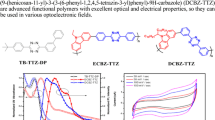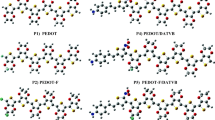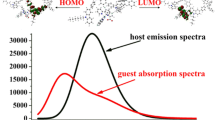Abstract
A new deep blue-emitting organic small molecule based on carbazole and thiophene rings was chemically synthesized using a Wittig reaction. The obtained material named carbazole–thiophene and denoted Cbz(–π–Th)2 was synthesized with a yield of 89%. The chemical structure of the Cbz(–π–Th)2 molecule was first confirmed experimentally by nuclear magnetic resonance (1H and 13C) and infrared spectroscopies. The photophysical properties of the synthesized molecule were studied by optical absorption and steady-state photoluminescence spectroscopies in a diluted solution state. The obtained material absorbs essentially in the ultraviolet part and the optical band gap \(\left( {E_{{\text{g}}}^{{{\text{opt}}}} } \right)\) was estimated to be at around 2.95 eV. By varying the excitation wavelength in the UV part, a broad blue emission is obtained with a high photoluminescence quantum yield (PLQY) of ~ 0.34 in solution. In addition, the International Commission on Illumination (CIE) coordinates obtained from the fluorescence results show that the Cbz(–π–Th)2 molecule exhibits a deep blue emission with CIE coordinates at around (0.18, 0.05) (CIEy < 0.1). Else, Density Functional Theory (DFT) and it is extended Time-dependent DFT methodologies were performed to evaluate the ground and the excited state of the examined molecule. Theoretical investigation confirms first the chemical structure and allows the investigation of the structural and electronic properties of the synthesized Cbz(–π–Th)2 molecule. In the second step, the chemical structure of the synthesized material was used as a photoactive layer in a multilayer structure forming a new generation of a simulated organic light-emitting diode. DFT results show that insertion of carbon based-molecule, especially a graphene monolayer, permits to reduce the energy of the electron injection barrier (ΔEe) from the used cathode to the Cbz(–π–Th)2 active layer, which permits to enhance the performance of the designed organic devices.












Similar content being viewed by others
Data availability
The authors confirm that the data supporting the findings of this study are available within the article.
References
T.Y.L. Liu, Z. Xie, Y. Ma, Sci. China Chem. (2015). https://doi.org/10.1007/s11426-015-5409-7
G. Xia, C. Qu, Y. Zhu, J. Ye, K. Ye, Z. Zhang, Y. Wang, Angew. Chem. (2021). https://doi.org/10.1002/anie.202100423
X. Cao, D. Zhang, S. Zhang, Y. Tao, W. Huang, J. Mater. Chem. C (2017). https://doi.org/10.1039/c7tc02481a
D. Corre Santos, M.F. de Vieira Marques, J. Mater. Sci. Mater. Electron. (2022). https://doi.org/10.1007/s10854-022-08333-3
M. Yıldırım, A. Erdoğan, Ã.F. Yüksel, M. Kuş, M. Can, Ã. Akın, N. Tuğluoğlu, J. Mater. Sci. Mater. Electron. (2019). https://doi.org/10.1007/s10854-019-01382-1
C. Xue, H. Lin, G. Zhang, Y. Hu, W. Jiang, J. Lang, D. Wang, G. Xing, J. Mater. Sci. Mater. Electron. (2020). https://doi.org/10.1007/s10854-020-03060-z
G.M. Farinol, R. Ragni, Chem. Soc. Rev. (2011). https://doi.org/10.1039/C0CS00204F
Y. Li, J.Y. Liu, Y.D. Zhao, Y.C. Cao, Mater. Today (2017). https://doi.org/10.1016/j.mattod.2016.12.003
G. Hong, X. Gan, C. Leonhardt, Z. Zhang, J. Seibert, J.M. Busch, S. Bräse, Adv. Mater. (2021). https://doi.org/10.1002/adma.202005630
V.G. Sree, C. Bathula, H.K. Youi, H.S. Kim, J.I. Sohn, H. Im, J. Mol. Liq. (2021). https://doi.org/10.1016/j.molliq.2021.116708
X. Cai, S.J. Su, Adv. Funct. Mater. (2018). https://doi.org/10.1002/adfm.201802558
C.L. Ho, W.Y. Wong, New. J. Chem. (2013). https://doi.org/10.1039/C3NJ00170A
J. Li, R. Liu, Z. Zhao, Z. Zhou, J. Mater. Sci. Mater. Electron. (2014). https://doi.org/10.1007/s10854-014-1831-4
B. Wex, B.R. Kaafarani, J. Mater. Chem. C (2017). https://doi.org/10.1039/C7TC02156A
T. Lu, J. You, D. Zhao, H. Wang, Y. Miao, X. Liu, Y. Xiao, X. Li, S. Wang, J. Mater. Sci. Mater. Electron. (2015). https://doi.org/10.1007/s10854-015-3254-2
M. Reig, C. Gozlvez, R. Bujaldon, G. Bagdziunas, K. Ivaniuk, N. Kostiv, D. Volyniuk, J.V. Grazulevicius, D. Velasco, Dye Pigments (2017). https://doi.org/10.1016/j.dyepig.2016.09.062
N. Agarwal, P.K. Nayak, F. Ali, M.P. Patankarb, K.L. Narasimhan, N. Periasamy, Synth. Met. (2011). https://doi.org/10.1016/j.synthmet.2011.01.001
P. Wang, S. Fan, J. Liang, L. Ying, J. You, S. Wang, X. Li, Dye Pigments (2017). https://doi.org/10.1016/j.dyepig.2017.03.036
L.A. Lozano-Hernández, J.L. Maldonado, C. Garcias-Morales, A. Espinosa Roa, O. Barbosa-García, M. Rodríguez, E. Pérez-Gutiérrez, J. Mol. (2018). https://doi.org/10.3390/molecules23020280
A.D. Becke, Density-functional exchange-energy approximation with correct asymptotic behavior. Phys. Rev. A 38(6), 3098–3100 (1988)
M.J. Frisch, G.W. Trucks, H.B. Schlegel, G.E. Scuseria, M.A. Robb, J.R. Cheeseman, G. Scalmani, V. Barone, B. Mennucci, G. Petersson, H. Nakatsuji et al., Gaussian09 revision D.01 (Gaussian Inc, Wallingford, 2009)
C. Lee, W. Yang, R.G. Parr, Phys. Rev. B 37, 785 (1998)
A.D. Becke, J. Chem. Phys. 104, 1040 (1996)
R. Dennington, T. Keith J. Millam, (2009) GaussView, Version 5, Semichem Inc, Shawnee mission KS
M.P. Andersson, P. Uvdal, J. Phys. Chem. A (2005). https://doi.org/10.1021/jp045733a
Y. Ben Salah, A.S. Altowyan, M. Mbarek, K. Alimi, Polymers (2021). https://doi.org/10.3390/polym13111805
M. Mbarek, M.M. Almoneef, Y. ben Saleh, K. Alimi, Spectrochim. Acta Part A Mol. Biomol. Spectrosc. (2021). https://doi.org/10.1016/j.saa.2021.119509
J.L. Sauvajol, C. Chorro, J.P. Lère-Porte, R.J. Corriu, J.J. Moreau, P. Thépot, M.W.C. Man, Synth. Metals (1994). https://doi.org/10.1016/0379-6779(94)90211-9
D.F. Machado, T.O. Lopes, I.T. Lima, D.A. Silva Filho, H.C. de Oliveira, J. Phys. Chem. C (2016). https://doi.org/10.1021/acs.jpcc.6b01567
N. Bouzayen, H. Sadki, M. Mbarek, M. Bouachrine, M.N. Bennani, J. Wéry, K. Alimi, Polym. Test. (2018). https://doi.org/10.1016/j.polymertesting.2017.12.023
M. Chemek, S.B. Amor, W. Taouali, E. Faulques, M. Bourass, D. Khlaifia, A.H. Said, K. Alimi, J. Mol. Struct. Vol. (2021). https://doi.org/10.1016/j.molstruc.2021.130599
M. Mbarek, M.M. Almoneef, K. Alimi, J. Mol. Struct. (2020). https://doi.org/10.1016/j.molstruc.2020.128384
A. Iraqi, I. Wataru, J. Chem. Mater. (2004). https://doi.org/10.1021/cm031078s
N.M. O’Boyle, A.L. Tenderholt, K.M. Langner, J. Comput. Chem. 29, 839–845 (2008). https://doi.org/10.1002/jcc.20823
M. Chemek, D. Khlaifia, F. Massuyeau, J.L. Duvail, E. Faulques, J. Wéry, K. Alimi, Synth. Metals (2014). https://doi.org/10.1016/j.synthmet.2014.09.004
M. Chemek, J. Wéry, M. Bouachrine, M. Paris, S. Lefrant, K. Alimi, Synth. Met. (2010). https://doi.org/10.1016/j.synthmet.2010.09.001
O.F. Yüksel, M. Kuş, M. Yıldırım, J. Electron. Mater. (2016). https://doi.org/10.1007/s11664-016-4999-y
H. Sasabe, J. Kido, J. Mater. Chem. C (2013). https://doi.org/10.1039/C2TC00584K
Acknowledgements
The authors acknowledge King Abdulaziz University’s High-Performance Computing Center (Aziz Supercomputer) for supporting the computational DFT calculation done in this work. The authors are grateful to Pr Chtourou Radhouane for the authorization access to the experimental analysis done in Technopark Borj Cedria (CRTEn), Tunisia.
Funding
The authors have not disclosed any funding.
Author information
Authors and Affiliations
Contributions
All authors contributed to the present work. Material preparation and experimental analysis were performed by CM, MB, AM, OH, and KA. Theoretical analysis was performed by CM, AM, and NW. The first draft of the manuscript was written by CM and all authors commented on previous versions of the manuscript. All authors read and approved the final manuscript.
Corresponding author
Ethics declarations
Conflict of interest
The authors declare that they have no conflicts of interest.
Additional information
Publisher’s Note
Springer Nature remains neutral with regard to jurisdictional claims in published maps and institutional affiliations.
Rights and permissions
Springer Nature or its licensor (e.g. a society or other partner) holds exclusive rights to this article under a publishing agreement with the author(s) or other rightsholder(s); author self-archiving of the accepted manuscript version of this article is solely governed by the terms of such publishing agreement and applicable law.
About this article
Cite this article
Chemek, M., Braiek, M.B., Mabrouk, A. et al. Optoelectronic properties of a new luminescent-synthesized organic material based on carbazole and thiophene rings for a new generation of OLEDs devices: experimental investigations and DFT modeling. J Mater Sci: Mater Electron 34, 1706 (2023). https://doi.org/10.1007/s10854-023-11068-4
Received:
Accepted:
Published:
DOI: https://doi.org/10.1007/s10854-023-11068-4




